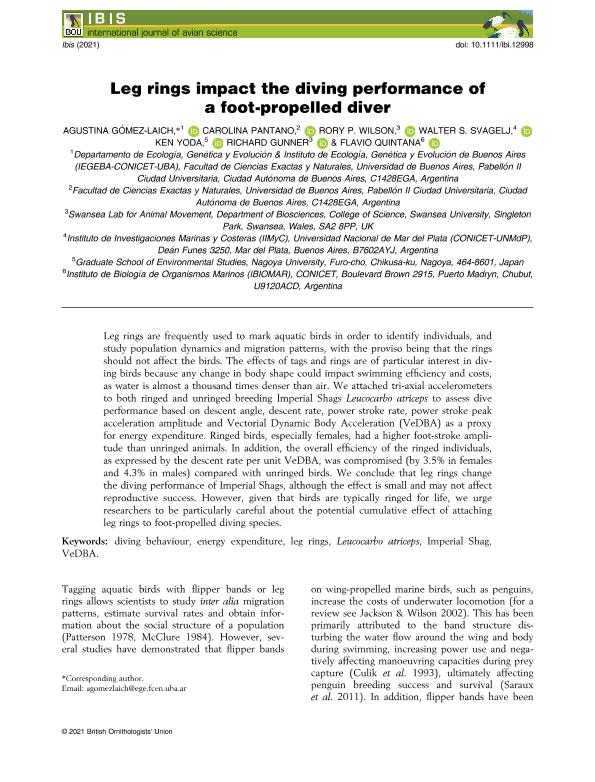Artículo
Leg rings impact the diving performance of a foot-propelled diver
Gómez Laich, Agustina Marta ; Pantano, Carolina; Wilson, Rory P; Svagelj, Walter Sergio
; Pantano, Carolina; Wilson, Rory P; Svagelj, Walter Sergio ; Yoda, Ken; Gunner, Richard; Quintana, Flavio Roberto
; Yoda, Ken; Gunner, Richard; Quintana, Flavio Roberto
 ; Pantano, Carolina; Wilson, Rory P; Svagelj, Walter Sergio
; Pantano, Carolina; Wilson, Rory P; Svagelj, Walter Sergio ; Yoda, Ken; Gunner, Richard; Quintana, Flavio Roberto
; Yoda, Ken; Gunner, Richard; Quintana, Flavio Roberto
Fecha de publicación:
07/2021
Editorial:
Wiley Blackwell Publishing, Inc
Revista:
Ibis
ISSN:
0019-1019
Idioma:
Inglés
Tipo de recurso:
Artículo publicado
Clasificación temática:
Resumen
Leg rings are frequently used to mark aquatic birds in order to identify individuals, and study population dynamics and migration patterns, with the proviso being that the rings should not affect the birds. The effects of tags and rings are of particular interest in diving birds because any change in body shape could impact swimming efficiency and costs, as water is almost a thousand times denser than air. We attached tri-axial accelerometers to both ringed and unringed breeding Imperial Shags Leucocarbo atriceps to assess dive performance based on descent angle, descent rate, power stroke rate, power stroke peak acceleration amplitude and Vectorial Dynamic Body Acceleration (VeDBA) as a proxy for energy expenditure. Ringed birds, especially females, had a higher foot-stroke amplitude than unringed animals. In addition, the overall efficiency of the ringed individuals, as expressed by the descent rate per unit VeDBA, was compromised (by 3.5% in females and 4.3% in males) compared with unringed birds. We conclude that leg rings change the diving performance of Imperial Shags, although the effect is small and may not affect reproductive success. However, given that birds are typically ringed for life, we urge researchers to be particularly careful about the potential cumulative effect of attaching leg rings to foot-propelled diving species.
Archivos asociados
Licencia
Identificadores
Colecciones
Articulos(IBIOMAR)
Articulos de INSTITUTO DE BIOLOGIA DE ORGANISMOS MARINOS
Articulos de INSTITUTO DE BIOLOGIA DE ORGANISMOS MARINOS
Articulos(IEGEBA)
Articulos de INSTITUTO DE ECOLOGIA, GENETICA Y EVOLUCION DE BS. AS
Articulos de INSTITUTO DE ECOLOGIA, GENETICA Y EVOLUCION DE BS. AS
Articulos(IIMYC)
Articulos de INSTITUTO DE INVESTIGACIONES MARINAS Y COSTERAS
Articulos de INSTITUTO DE INVESTIGACIONES MARINAS Y COSTERAS
Citación
Gómez Laich, Agustina Marta; Pantano, Carolina; Wilson, Rory P; Svagelj, Walter Sergio; Yoda, Ken; et al.; Leg rings impact the diving performance of a foot-propelled diver; Wiley Blackwell Publishing, Inc; Ibis; 164; 1; 7-2021; 118-131
Compartir
Altmétricas



